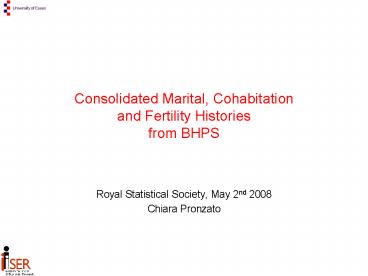Consolidated Marital, Cohabitation and Fertility Histories from BHPS PowerPoint PPT Presentation
1 / 15
Title: Consolidated Marital, Cohabitation and Fertility Histories from BHPS
1
Consolidated Marital, Cohabitation and Fertility
Historiesfrom BHPS
- Royal Statistical Society, May 2nd 2008
- Chiara Pronzato
2
Introduction
- The consolidated marital, cohabitation and
fertility file contains retrospective lifetime
histories and subsequent panel data related to
respondents partnerships and childbearing - It contains 30,549 adults interviewed at least
once during the survey - Every date is calculated as months elapsed since
January 1900 - When we are not sure about the month, we denote
it to be June and we add .5 at the end - Missing dates are set to -1
3
General information
- Time-invariant variables
- pp person identification number
- sex gender
- birth date of birth
- Time-variant variables
- hh_ household identification number
- region_ region of residence
4
Fertility historyThe variables
- childbirth_ date of birth from the oldest to
the youngest child - twin_ indicates whether the birth is a
singleton, twins or triplets - fertility provides the source of information
5
Fertility historySource of information
No retrospective interview - no children in the hh
Retrospective interview newborn children
No retrospective interview children in the hh
6
Fertility historySome descriptives
7
Union historiesThe variables
- From the retrospective histories and the panel we
can determine how many unions each respondent has
had during their life up to their last interview
in the panel - For those without a retrospective history, we can
observe how many they have had during the panel - union_ type indicator variable equal to 1 when
it is a marriage, to 2 when it is cohabitation
and 0 otherwise - start_date_ starting date
- left_ for some unions we do not know the start
date these are indicated by a value of 1 for the
indicator variable for left censoring. For such
unions the variable start_date_ gives the first
date in which we observe them in the union. - stop_date date of the end of the each union
8
Union historiesThe variables
- end_ how the union ended
- If the union type is equal to 1 (marriage)
- the partner can die (widowhood, end_1)
- they can get divorced (end_2) separation_
(when available) - separate (end_3)
- or they can be currently together (end_6)
- if the union type is equal to 2 (cohabitation)
- they can split (end_4),
- get married (end_5)
- or they can be currently together (end_6).
9
Union historiesThe variables
- partner_ pid number of the partner (when
available) - marital indicates the source of information
10
Union historiesMarriages - Source of information
No retrospective history but changes in marital
status during the panel
No retrospective history no changes in marital
status during the panel
Retrospective history changes in marital status
during the panel
11
Union historiesCohabitations - Source of
information
Main difference from marriage histories (for the
panel) no change in marital status, but
relationships in the hh entry / exit from the
house
12
Union historiesSome descriptives
13
Union historiesSome descriptives
14
An example(Ermisch, Pronzato, EJ 2008)
- Financial support from fathers who have children
living elsewhere, and have formed new
relationships - To understand the influence of the second-wife
on the transfers the fathers makes to children
living with the first-wife
15
An example(Ermisch, Pronzato, EJ 2008)
cohabitation
marriage
May 1980
September 2003
June 1985
September 1990
July 1998 child aged 16
July 1982 childbirth
Child support due

